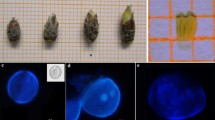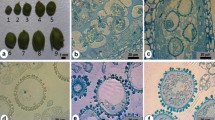Abstract
Studies were undertaken with one olive (Olea europaea L.) cultivar to identify buds with microspores competent to embryogenesis in vitro. Isolated microspore cultures were performed for the induction of gametic embryogenesis. Different pollen development stages and stress conditions (heat or cold shock) were evaluated. The correlation of inflorescence, anther morphology and the suitable stage of microspore development were analysed. The morphology of responsive buds was identified which corresponded with microspores from the late uni-nucleate to early bi-nucleate pollen stages. Symmetrical divisions of microspores as well as resulting multinucleate structures and pro-embryos were observed. In this paper, a new method of isolated microspore culture that leads to cell division and pro-embryos in olive, is reported.
Similar content being viewed by others
References
Assani A., Bakry F., Kerbellec., Haícour R., Wenzel G., Foroughi-Wehr B. 2003. Production of haploids from anther culture of banana [Musa balbisiana (BB)]. Plant Cell Rep. 21: 511–516.
Bajaj Y.P.S., Dhanju, M.S. 1983. Pollen embryogenesis in three ornamental trees Cassia fistula, Jacaranda acutifolia and Poinciana regia. J. Tree Sci. 2: 16–19.
Baldursson S., Nørgaard J.V., Krogstrup P. Andersen S.B. 1993. Microspore embryogenesis in anther culture of three species of Populus, and regeneration of dihaploid plants of Populus trichocarpa. Can. J. For. Res. 23: 1812–1825.
Barro F., Martin A., 1999. Response of different genotypes of Brassica carinata to microspore culture. Plant Breeding 118: 79–81
Bayliss K.L., Wroth J.M., Cowling W.A, 2004. Pro-embryos of Lupinus spp. produced from isolated microspore culture. Austr. J. Agricult. Res. 55: 589–593.
Bueno M.A., Gómez A., Boscaiu M., Manzanera J.A., Vicente O. 1997. Stress-induced formation of haploid plants through anther culture in cork-oak (Quercus suber L.). Physiol. Plant. 99: 335–341.
Chen Z, 1990. Rubber (Hevea brasiliensis (Muell.) Arg.): in vitro production of haploids. In: Biotechnology in Agriculture and Forestry, ed. by Y.P.S. Bajaj. Haploids in crop improvement 1. Vol. 12, Springer, Berlin: 215–236
Deutsch F., Kumlehn J., Ziegenhagen B., Fladung M. 2004. Stable haploid poplar callus lines from immature pollen culture. Physiol. Plant. 120: 613–622.
Guo Y.D., Pulli S. 2000. An efficient androgenic embryogenesis and plant regeneration method through isolated microspore culture in timothy (Phleum pratense L.). Plant Cell Rep. 19: 761–767.
Herrera J.C., Moreno L.G., Acu a J.R., De la Pe a M., Osorio D. 2002. Colchicine induced microspore embryogenesis in coffee. Plant Cell Tiss. Org. Cult. 71: 89–92.
Höfer M. 2004. In vitro androgenesis in apple — improvement of the induction phase. Plant Cell Rep. 22: 365–370.
Höfer M., Touraev A., Heberle-Bors E. 1999. Induction of embryogenesis from isolated apple microspores. Plant Cell Rep. 18: 1012–1017.
Hu T., Kasha KJ. 1999. A cytological study of pretreatments used to improve isolated microspore cultures of wheat (Triticum aestivum L.) cv. Chris. Genome 42: 432–441.
Indrianto A., Barinova I., Touraev A., Heberle-Bors E. 2001. Tracking individual wheat microspores in vitro: identification of embryogenic microspores and body axis formation in the embryo. Planta 212: 163–174.
Jähne A., Lörz H. 1995. Cereals microspore culture. Plant Sci. 109: 1–12.
Jörgensen J. 1988. Embryogenesis in Quercus petraea and Fagus sylvatica. J. Plant Physiol. 132: 638–640
Kyo M., and Harada H. 1986. Control of the developmental pathway of tobacco pollen in vitro. Planta 168: 427–432.
Lichter R. 1982. Induction of haploids plants from isolated pollen of Brassica napus. Z Pflanzenphysiol. 105:427–434.
Radojevic L., Jordgevic N., Tucic B. 1989. In vitro pollen embryos and plantlets in Aesculus carnea Hayne through anther culture. Plant Cell. Tiss. Org. Cult. 17: 21–26.
Thanh-Tuyen N.T., De Guzman E.V. 1983. Formation of pollen embryos in cultured anthers of coconut (Cocos nucifera L.). Plant Sci. Lett 29: 81–88.
Touraev A., Vicente O., Heberle-Bors E. 1997. Initiation of microspore embryogenesis by stress. Trends Plant Sci. 2:297–302.
Zaki M.A.M., Dickinson H.G. 1991. Microspore-derived embryos in Brassica: the significance of division symmetry in pollen mitosis I to embryogenic development. Sex. Plant Reprod. 4: 48–55.
Zheng Y.M. 2003. Microspore culture in wheat (Triticum aestivum)-doubled haploid production via induced embryogenesis. Plant Cell Tiss. Org. Cult. 73: 213–230.
Author information
Authors and Affiliations
Corresponding author
Rights and permissions
About this article
Cite this article
Bueno, M.A., Pintos, B., Höfer, M. et al. Pro-embryos induction from Olea europaea L. isolated microspore culture. Acta Physiol Plant 27, 695–701 (2005). https://doi.org/10.1007/s11738-005-0073-8
Accepted:
Issue Date:
DOI: https://doi.org/10.1007/s11738-005-0073-8




